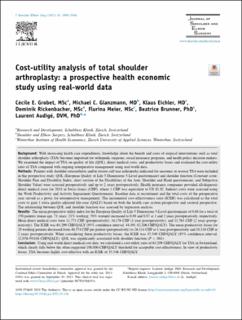Please use this identifier to cite or link to this item:
https://doi.org/10.21256/zhaw-22264| Publication type: | Article in scientific journal |
| Type of review: | Peer review (publication) |
| Title: | Cost-utility analysis of total shoulder arthroplasty : a prospective health economic study using real-world data |
| Authors: | Grobet, Cécile Glanzmann, Michael C. Eichler, Klaus Rickenbacher, Dominik Meier, Flurina Brunner, Beatrice Audigé, Laurent |
| et. al: | No |
| DOI: | 10.1016/j.jse.2021.03.136 10.21256/zhaw-22264 |
| Published in: | Journal of Shoulder and Elbow Surgery |
| Volume(Issue): | 30 |
| Issue: | 9 |
| Page(s): | 1998 |
| Pages to: | 2006 |
| Issue Date: | 2021 |
| Publisher / Ed. Institution: | Elsevier |
| ISSN: | 1058-2746 1532-6500 |
| Language: | English |
| Subjects: | European Quality of Life EQ-5D; Cost-effectiveness; Cost-utility; Incremental cost-effectiveness ratio; Quality of life; Real-world data; Total shoulder arthroplasty |
| Subject (DDC): | 362.1041: Health economics |
| Abstract: | Background: With increasing health care expenditures, knowledge about the benefit and costs of surgical interventions such as total shoulder arthroplasty (TSA) becomes important for orthopedic surgeons, social insurances and health policy decision makers. We examined the impact of TSA on quality of life (QOL), direct medical costs and productivity losses, and evaluated the cost-utility ratio of TSA compared to ongoing nonoperative management using real-world data. Methods: Patients with shoulder osteoarthritis and/or rotator cuff tear arthropathy indicated for anatomical or reverse TSA were included in this prospective study. Quality of life (EQ-5D-5L) and shoulder function (Constant Score, Shoulder Pain and Disability Index, short version of the Disabilities of the Arm, Shoulder and Hand questionnaire, Subjective Shoulder Value) were assessed before (preop) and up to 2 years after surgery (postop). Health insurance companies provided all-diagnoses direct medical costs for 2018 in Swiss francs (CHF), where 1 CHF was equivalent to 1.02 USD. Indirect costs were assessed using the work productivity and activity impairment questionnaire. Baseline data at recruitment and the total costs of the preop year served as a proxy for nonoperative management. The incremental cost-effectiveness ratio (ICER) was calculated as the total costs to gain one extra quality-adjusted life year (QALY) based on both the health care system and societal perspective. The relationship between QOL and shoulder function was assessed by regression analysis. Results: The mean preOP EQ-5D-5L utility index of 0.68 for a total of 150 patients (mean age 71 years; 21% working; 58% female) increased to 0.89 and 0.87 at 1 and 2 years postop, respectively. Mean direct medical costs were 11,771 CHF (preop), 34,176 CHF (1 year postop) and 11,763 CHF (2 years postop). The ICER was 63,299 CHF/QALY (95% confidence interval [CI]: 44,391; 82,206). Mean productivity losses for 30 working patients decreased from 40,574 CHF per patient (preop) to 26,114 CHF at 1 year postop and 10,310 CHF at 2 years postop. When considering these productivity losses, the ICER was 35,549 CHF/QALY (95% CI: 12,076; 59,016). Quality of life was significantly associated with shoulder function (p < 0.001). Conclusion: Using real-world direct medical cost data, we calculated a cost-utility ratio of 63,299 CHF/QALY for TSA in Switzerland, which clearly falls below the often suggested 100,000 CHF/QALY threshold for acceptable cost-effectiveness. In view of productivity losses, TSA becomes highly cost-effective with an ICER of 35,546 CHF/QALY. |
| URI: | https://digitalcollection.zhaw.ch/handle/11475/22264 |
| Fulltext version: | Published version |
| License (according to publishing contract): | CC BY-NC-ND 4.0: Attribution - Non commercial - No derivatives 4.0 International |
| Departement: | School of Management and Law |
| Organisational Unit: | Winterthur Institute of Health Economics (WIG) |
| Appears in collections: | Publikationen School of Management and Law |
Files in This Item:
| File | Description | Size | Format | |
|---|---|---|---|---|
| 2021_Grobet-etal_Cost-utilitiy-analysis-of-total-shoulder-arthroplasty.pdf | 735.42 kB | Adobe PDF |  View/Open |
Show full item record
Grobet, C., Glanzmann, M. C., Eichler, K., Rickenbacher, D., Meier, F., Brunner, B., & Audigé, L. (2021). Cost-utility analysis of total shoulder arthroplasty : a prospective health economic study using real-world data. Journal of Shoulder and Elbow Surgery, 30(9), 1998–2006. https://doi.org/10.1016/j.jse.2021.03.136
Grobet, C. et al. (2021) ‘Cost-utility analysis of total shoulder arthroplasty : a prospective health economic study using real-world data’, Journal of Shoulder and Elbow Surgery, 30(9), pp. 1998–2006. Available at: https://doi.org/10.1016/j.jse.2021.03.136.
C. Grobet et al., “Cost-utility analysis of total shoulder arthroplasty : a prospective health economic study using real-world data,” Journal of Shoulder and Elbow Surgery, vol. 30, no. 9, pp. 1998–2006, 2021, doi: 10.1016/j.jse.2021.03.136.
GROBET, Cécile, Michael C. GLANZMANN, Klaus EICHLER, Dominik RICKENBACHER, Flurina MEIER, Beatrice BRUNNER und Laurent AUDIGÉ, 2021. Cost-utility analysis of total shoulder arthroplasty : a prospective health economic study using real-world data. Journal of Shoulder and Elbow Surgery. 2021. Bd. 30, Nr. 9, S. 1998–2006. DOI 10.1016/j.jse.2021.03.136
Grobet, Cécile, Michael C. Glanzmann, Klaus Eichler, Dominik Rickenbacher, Flurina Meier, Beatrice Brunner, and Laurent Audigé. 2021. “Cost-Utility Analysis of Total Shoulder Arthroplasty : A Prospective Health Economic Study Using Real-World Data.” Journal of Shoulder and Elbow Surgery 30 (9): 1998–2006. https://doi.org/10.1016/j.jse.2021.03.136.
Grobet, Cécile, et al. “Cost-Utility Analysis of Total Shoulder Arthroplasty : A Prospective Health Economic Study Using Real-World Data.” Journal of Shoulder and Elbow Surgery, vol. 30, no. 9, 2021, pp. 1998–2006, https://doi.org/10.1016/j.jse.2021.03.136.
Items in DSpace are protected by copyright, with all rights reserved, unless otherwise indicated.